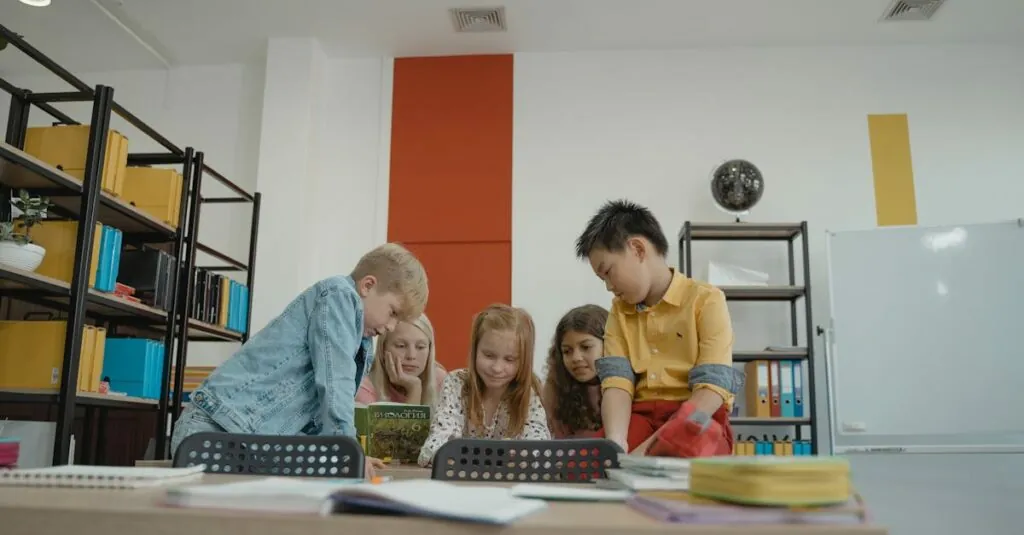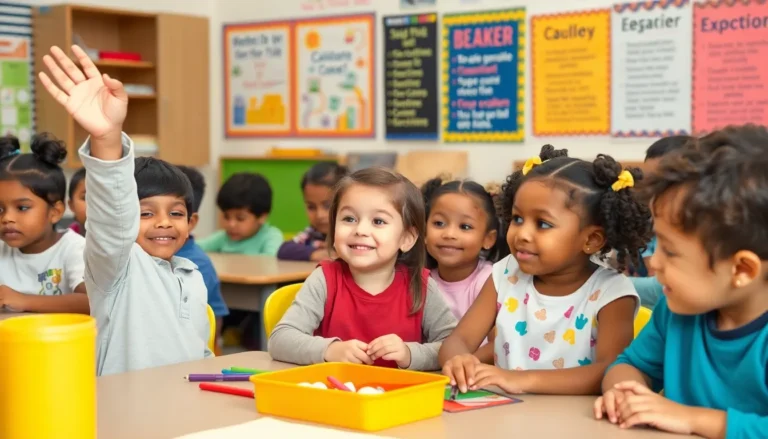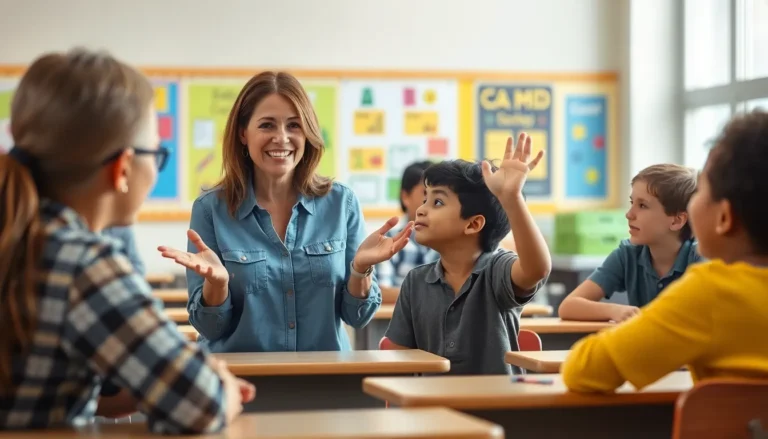Table of Contents
ToggleRemember the thrill of diving into a new book as a kid in the 2000s? Those were the days when pages were dog-eared and imaginations ran wild. From quirky characters to fantastical adventures, elementary school books from that era had a unique charm that still tugs at the heartstrings today.
Overview of Elementary School 2000s Kids Books
Elementary school kids in the 2000s enjoyed a diverse array of books that captured their imaginations. Series like “Harry Potter” by J.K. Rowling captivated readers with magical tales, encouraging a love for reading. Authors like Jeff Kinney, with “Diary of a Wimpy Kid,” combined humor and relatable scenarios, resonating with children facing similar everyday challenges.
Many books featured themes of friendship and adventure, making them relatable to the young audience. “The Percy Jackson & The Olympians” series by Rick Riordan introduced mythology in a fun way, blending education with entertainment.
Illustrated stories played a prominent role during this time as well. Picture books like “Don’t Let the Pigeon Drive the Bus!” by Mo Willems highlighted engaging visuals and simple texts, appealing to early readers. Graphic novels began gaining popularity, with titles like “Bone” by Jeff Smith capturing both kids and reluctant readers.
Children’s literature in the 2000s also emphasized social issues. Books like “Wonder” by R.J. Palacio taught empathy and kindness, pushing narratives about differences and acceptance.
Diverse characters became more prominent in literature. Books featuring protagonists of various backgrounds encouraged inclusivity, reflecting the multicultural shifts in society. Series like “The Amelia Rules!” by Jimmy Gownley showcased strong female leads, inspiring young girls.
Overall, 2000s kids books combined whimsy with essential life lessons, leaving a lasting impact on literacy and social awareness. The magic of these stories continues to resonate, reflecting not just a decade, but a generation of readers.
Popular Genres
The 2000s featured a rich variety of genres that captivated elementary school readers. Kids discovered stories filled with imagination and real-world connections.
Fantasy Adventures
Readers engaged with magical worlds in fantasy adventures. Series like “Harry Potter” captivated imaginations with spells, friendship, and bravery. Each book transported children to extraordinary realms, exploring themes like courage and sacrifice. “Percy Jackson & The Olympians” introduced Greek mythology in a thrilling context, making history fun and relatable. Enchanting characters like wizards, demigods, and fantastical creatures fostered excitement and wonder. Titles in this genre encouraged creativity, inspiring kids to envision their own adventures.
Realistic Fiction
Realistic fiction resonated through relatable situations and authentic experiences. Books like “Wonder” addressed bullying and kindness, promoting empathy among peers. Narratives often focused on friendship, family dynamics, and everyday challenges. Characters confronted real-life issues, providing children with valuable lessons in resilience. Stories captured the essence of growing up, encouraging readers to reflect on their feelings and relationships. This genre allowed kids to see themselves in the characters, fostering understanding and connection in their own lives.
Notable Authors of the 2000s
Several authors emerged in the 2000s, capturing the hearts of young readers through engaging stories and memorable characters. Their ability to weave together adventure and relatable themes solidified their place in children’s literature.
Series That Defined A Generation
J.K. Rowling’s “Harry Potter” series transformed fantasy literature for kids, making magic accessible and thrilling. Rick Riordan captivated readers with “Percy Jackson & The Olympians,” introducing them to Greek mythology in a captivating setting. Jeff Kinney’s “Diary of a Wimpy Kid” resonated with young audiences by presenting relatable experiences through humorous illustrations. Each series not only entertained but also inspired children to embrace reading, fostering a lifelong passion for literature. These authors significantly shaped the reading culture of the decade.
Standalone Classics
Titles like “Wonder” by R.J. Palacio sparked conversations around kindness and acceptance, becoming essential reading for young audiences. “The Giver” by Lois Lowry continued to engage children with its thought-provoking themes. Additionally, Sarah Pennypacker introduced readers to the heartwarming tale of “Pax,” reflecting on the bond between a boy and his pet. Such standalone classics left a lasting impression, encouraging children to think critically about life and emotion. Each book represented unique stories that resonated far beyond the pages.
Cultural Impact of 2000s Kids Books
2000s kids’ books shaped a generation, influencing literacy and social values. The rise of engaging series like “Harry Potter” sparked a widespread reading culture. Captivating themes of friendship and adventure became staples, connecting young readers to universal emotions.
Diverse characters emerged, reflecting societal changes and promoting inclusion. Books such as “Wonder” encouraged empathy and kindness while addressing bullying and self-acceptance. Readers found solace in characters navigating challenges similar to their own lives, fostering deeper connections to literature.
Illustrated stories and graphic novels also gained traction during the decade. These formats appealed to reluctant readers, making literature accessible. Titles like “Diary of a Wimpy Kid” combined humor with relatable situations, offering an inviting entry point into reading.
Noteworthy authors left a lasting mark on this era. J.K. Rowling’s magical worlds and Rick Riordan’s mythology-infused adventures entertained while instilling valuable lessons. Jeff Kinney’s humorous narratives highlighted the trials of childhood, cementing their relevance in modern literature.
Standalone novels made significant contributions too. “The Giver” by Lois Lowry encouraged critical thinking about society, while “Pax” by Sarah Pennypacker explored the deep bonds between humans and animals. Such stories ignited important conversations around personal growth and emotional intelligence.
Overall, the cultural impact of 2000s kids’ books extends beyond mere entertainment. These narratives helped shape young readers’ identities, promoting literacy while addressing pressing social issues. This generation of literature left an indelible mark, inspiring both readers and writers for years to come.
The magic of 2000s children’s books continues to resonate with readers today. These stories not only entertained but also instilled important values and fostered a love for reading. Through imaginative plots and relatable characters, they helped shape the identities of young readers and encouraged empathy and understanding.
As the literary landscape evolves, the influence of these beloved titles remains evident. They paved the way for diverse representation and meaningful conversations in children’s literature. The charm of 2000s kids’ books will forever hold a special place in the hearts of those who grew up with them, inspiring future generations to explore the world of reading.





